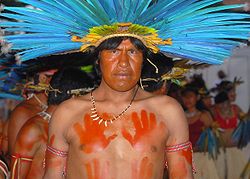Bororo

Bororo-Boe man from Mato Grosso at Brazil's Indigenous Games, 2007
|
|
| Total population | |
|---|---|
| 1,571 (2010) | |
| Regions with significant populations | |
|
|
|
| Languages | |
| Borôro, Portuguese | |
| Religion | |
| traditional tribal religion |
The Bororo are an indigenous people of Brazil, living in the state of Mato Grosso. They also extended into Bolivia and the Brazilian state of Goiás. The Western Bororo live around the Jauru and Cabaçal rivers. The Eastern Bororo (Orarimogodoge) live in the region of the São Lourenço, Garças, and Vermelho Rivers. The Bororo live in eight villages.
The Bororo, whose name means "village court" in their language, are also known as the Araés, Araripoconé, Boe, Coroados, Coxiponé, Cuiabá, and Porrudos people.
While searching for missing explorer Percy Fawcett in 1930, a wayward party including Aloha Wanderwell filmed the daily activities of the Bororo. A 32-minute silent film from the trip survives as part of the Smithsonian Institution's Human Studies Film Archives and documents a ceremonial dance, a first contact scenario with Boboré villagers, and Bororo men experiencing sympathetic labor pains. Anthropologist Claude Lévi-Strauss lived for some time among the Bororo during his first stay in Brazil (1935–1939). Their mythology features extensively in his book The Raw and the Cooked.
Marshal Cândido Rondon (1865–1956), who was to become the first director of Brazil's Indians Protection Bureau (SPI/FUNAI) and creator of the Xingu National Park, was the son of a Bororo woman. His first major success after joining the Army was the installation of a telegraph line to Mato Grosso. He not only was able to pacify the Bororo, who had blocked previous attempts to set up that line, but even recruited their help to complete it.
...
Wikipedia
